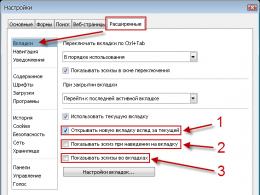How to set page numbers in Word. How to number pages in Microsoft Word How to arrange pages
It will be useful for every user who works seriously in the Microsoft Word text editor to know how to set page numbers.
You will need
- Microsoft Word text editor
Instructions
Instructions
Word 2007 is an excellent tool included in the Microsoft office suite and designed for processing text information. This editor is successfully used for preparing reports and abstracts, coursework and dissertations.
Significantly improves navigation through a multi-page document by creating a table of contents indicating the page numbers from which new chapters and sections begin. Numbering in Word 2007 is possible from any page, and the format of the numbers can also be changed. You can number pages in Word 2007 in several ways.
Quick navigation through the article
Simple numbering
If it is necessary to number all pages of a document, starting with number 1, the procedure will be as follows:
- Open the required document;
- Select the “Insert” command from the menu;
- In the “Header and Footer” group, click on the arrow next to “Page Number”;
- In the menu that opens, select the location and type of room;
- To change the number format, execute the command: “Insert” -> “Page Number” -> “Page Number Format” -> select the desired view;
Numbering without first page
The design of many text documents implies the presence of a title page, on which a number is not affixed (the second page should receive the number 2). For this type of numbering you need:
- Number the entire document as with simple numbering;
- Double-click on the first page in the footer area (near the number entered);
- In the “Options” group of the header and footer designer, check the “Special header for the first page” checkbox;
- Return to the document field by clicking on “Close header and footer window”, or double-click on the document field.
To make the number on the second page start with “1” and not with “2”, you need to go to: “Insert” -> “Page Number” -> “Page Number Format” -> and in the “Page Numbering” field select “Start” from 0".
Numbering from any document page
Documents with complex structures often require special numbering of different parts. To do this, Word 2007 uses sectioning (that is, there must be a new section on the page from which the new numbering should begin). To take advantage of this opportunity, you should:
- Go to the page after which a new section should begin;
- Select “Page Layout” -> “Breaks” in the menu and in the “Section Breaks” group click on “Next Page”;
- Enter the footer area of the desired section (double-click at the top or bottom of the page) and execute the command: “Insert” -> “Page number” -> select the desired type of numbering;
- If it is necessary for this numbering to stop on some page, you need to create a new section from this page and delete the number that has become unnecessary in the footer area.
If you are writing an essay, term paper, diploma or report, then for the convenience of the user or according to the requirements, the pages in the document must be numbered. Then another person who will read your work, having looked at the content, will easily find the necessary material.
If you are interested in the question of how to make content in Word, follow the link and read the article.
So, back to our topic. To make page numbering in MS Word, go to the "Insert" tab and find the "Header and Footer" section there.
Next click on the button "Page number". A drop-down menu will open in which you can select the location of the number on the page: at the top, bottom, or in the margins. Select the number that suits your document and click on it.

The pages will be numbered. To remove inscriptions "Footer", "Page header" and go to editing the text, double-click on the text with the left mouse button.

Now let's figure it out. First, we perform all the steps described above. Then you need to move on to editing page numbers. To do this, double-click at the top or bottom of the document, where the mouse italics will change to a pointer.

We will work in the area of footers. Go to the tab "Working with headers and footers"- “Constructor”. Check the box here "Special footer for the first page". After this, the page numbering in the document will be displayed from page 2 - while page 1 is taken into account, but is not numbered.

If you need, so that the numbering starts with a different number or letter, go back to editing page numbers. Here, on the “Design” tab, click the button "Page number" and select from the menu "Page Number Format".

The following window will appear. In it you can select “Number format” and specify the number from which page numbering will begin. For example, I have “start with”: 3. This means that the first sheet of the document is page number 3, the second is page number 4, and so on.

To ensure that page numbering starts from “1” from the second sheet of the document - that is, we do not count the first sheet of the document - put “0” in the “start from” field.
That's all. Numbering all pages in Word 2007 and Word 2010 is not so difficult. By following the recommendations, you will also be able to include numbering from page 2 of the document.
Rate this article:Page numbering in Word for a regular document is done very simply, but when the need arises to put page numbers in your own headers or footers or double page numbering, then some people begin to feel sad.
There's really nothing complicated. I suggest doing a little practical work, after which your work will become more fun and easier.
Simple pagination
First, a few words about how to number pages in Word for those who are encountering this for the first time:
In the top menu ribbon we go Insert → Page Number → Top of Page → Prime Number 1
Of course, you can choose absolutely any arrangement and style of page numbering; my choice is due to the compactness of the drawing. That's all, let's move on to get acquainted with more interesting things.
Page numbers in footers
The fact is that page numbers in Word are inserted into headers and footers, and if you have your own, the previous method will not work, because Everything in the document will be awry.
Healthy. If you are familiar with the concepts of headers and footers in Word, then I strongly recommend that you read the articles: “Headers and Footers in Word” (see) and “Sections in Word” (see).
How to number pages in Word
So, let's get started and do everything in order:
1. Download the prepared file for practical work.
2. Go to the editing mode of the header of the first page of content (if you have difficulty, see).
3. Place the cursor in the rectangle in the upper right corner and press the keyboard shortcut Ctrl+F9, after which it will appear { } .

4. Write or copy the code in these brackets PAGE .
5. Press the keyboard shortcut Alt+F9, this will display the meaning of the code.
6. Exit the header-footer editing mode (if you find it difficult, see).
7. Since, in our example, there is a special footer for the first page, it is necessary to do this for subsequent content pages. Go to the second page and do it.
8. Numbering has been set, but as a rule it does not start from the first page. Go to the first page header editing mode and highlight the page number by going to the top menu ribbon Insert → Page Number → Page Number Format… and specify that page numbering should start at 4.

Thus, continuous numbering is provided for subsequent sections of the explanatory note and appendices. For simplicity, you can copy the page number of the contents, in the header-footer editing mode, and paste it into subsequent sections.
Double pagination in Word
So, we have sorted out the continuous numbering of pages in Word, but it is also necessary to put the sheet numbers of each section separately for the contents, notes and appendices.
Let's continue step by step, from simple to complex:
9. Go to the footer editing mode of the second page of contents and place the cursor in the lower right corner in the appropriate place.
10. Paste the code into this cell (=(page)-3) similarly, creating curly braces with a keyboard shortcut Ctrl+F9. Page number 2 was obtained by decreasing the value of the current page by 3, as can be seen from the code.
You can check the result by adding a contents page.
Page numbering in Word for the pros
The previous method can also be used to number subsequent internal pages of sections, but the problem is that you will constantly have to monitor the number of the last page of the previous section. Damn, I could probably rest here, my head is starting to get warm.
Let's do this, if in this example you have the second page of section explanatory note 7, then you will have to get the internal numbering of the second page like this (=(page)-5), if the number of pages of content increases by one, then the number of the second page of the note will be 8, and the internal one will have to be written as (=(page)-6) .
We can automate this too, we do it sequentially, and everything will become clear along the way:
11. Turn on the visibility of hidden characters by clicking the corresponding button on the main tab of the top menu, and select the entire line
::::::::Section break (from next page):::::::::

This inscription must be on a separate line, otherwise move it with the cursor at the beginning and press Enter. To select, move the cursor from the beginning to the end of the points, or click opposite the line outside the sheet space.
12. With a line highlighted in the top menu Insert → Bookmark in the “Bookmark” window we write r1(analogous to section 1, in Latin letters without spaces), set “Hidden bookmarks” and click “Add”.

13. Go to edit the footer of the second page of the explanatory note and insert the code into the page number cell (=(page)-(pageRef r1) .
It should be interpreted as follows: code (page) indicates the page number, in our case 7, and (pageRef r1) the cross-reference page number created at the section break, which is on page 5, so the internal page number is calculated as the page number minus the last page number of the previous section, i.e. 7-5=2; 8-5=3; 9-5=4, etc.
14. Do the same for the applications section yourself by adding a bookmark r2 to break the section at the end of the explanatory note.
The final touch to page numbering
Go sequentially to the first page of each section, and in the cell under the inscription “Sheets” in the lower right corner, put the code (SectionPages). This code will display the total number of pages in the section. If you need to display the total number of pages in the document, insert the code (NUMPAGES) .
It happens that word slows down and does not always update fields with codes; to force updating, press the key combination twice Alt+F9.
Let me remind you that parentheses for inserting code are called by the combination Crtl+F9, and calling the values Alt+F9.
Bonus. Well, in the end, if there were any difficulties, you can download the document with the finished result by clicking.
Interesting. Read how to make an automatic table of contents in Word.
Page numbering in word. Video tutorial
Will definitely be there as soon as time comes...
We often work with texts in Microsoft Word. For better navigation in the document, you need to make page numbers. Not everyone knows how to number pages in Word, so let’s consider this issue.
How to make page numbers in Word 2007, 2010, 2013 and 2016
To set page numbering in Word, open the “Insert” menu - “Page Number”.
Versions of Word 2007, 2010, 2013 and 2016 do this the same way.

Choose the numbering position: top or bottom of the page, and then the style: left, center, or right.

Word will automatically number the entire document.
Then double-click outside the header and footer area or click the "Close Header and Footer Window" button.

Removing a number from the first page of a document
If you don't want to put a number on the first page, then go to the "Insert" menu and select "Footer" - "Change Footer" or "Header" - "Change Header", depending on where you have the number .

The tab “Working with Headers and Footers” - “Design” will open. Click on “Special first page footer” in the options.

In the Header and Footer area, highlight and delete the page number. Click "Close Header and Footer Window" or ESC button.
How to put numbering not from the beginning of the document
To start numbering not from the first sheet of the document, you need to break it into sections, disconnect the connection between them and add numbers.
Go to the part of the document where you want to start numbering and insert a section break. To do this, on the “Page Layout” menu tab, select the “Breaks” - “Next Page” command.

Double-click on the top or bottom of the page where you need to put the numbers. The menu “Working with Headers and Footers” - “Design” will open. Click on “Same as previous section” to remove the connection of the header and footer with the previous section of the document.

The header and footer are linked separately. If the numbering is at the top of the document, unlink the headers; if the numbers are at the bottom, unlink the footers.
Then set the numbering: “Insert” - “Page Number” and select the desired layout.

Go back to Page Number - Page Number Format.

In the next window, next to “start with”, write 1 so that the numbering starts from 1 and click “OK”. Otherwise, Word will accept the actual number.

How to start pagination with a number other than 1
In the “Page Number Format” window (picture above), you can set a different initial numbering.
Double-click in the header or footer area. The “Working with Headers and Footers” tab is activated. Go to the “Insert” - “Page Number” tab and select the appropriate style.

In the new window, in the “Page Numbering” section next to “start with”, write the number you need and click “OK”.







